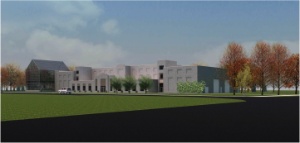Apr 12 2010
The Naval Research Laboratory (NRL) held a groundbreaking ceremony today, April 8, 2010, to mark the start of construction of a major new facility called the Autonomous Systems Research Laboratory.
The new facility, which will cost more than $17.7 million to construct, will integrate science and technology components into research prototype systems and will become the nerve center for basic research that supports autonomous systems research for the Navy and Marine Corps. The estimated completion of construction of the nearly 50,000 square foot laboratory is May 2011. The new laboratory will be located at NRL Washington, D.C. between existing buildings 72 and 32.
 The Autonomous Systems Research Laboratory, a nearly 50,000 square foot facility, is scheduled to be completed in May 2011
The Autonomous Systems Research Laboratory, a nearly 50,000 square foot facility, is scheduled to be completed in May 2011
With specialized laboratories housed in the Autonomous Systems Research Laboratory, NRL will enhance its science and technology (S&T) capabilities in key areas, including power and energy, sensors, intelligent autonomy, and platform development. The unique facility offers the opportunity for scientists and engineers to conduct multidisciplinary research in three unique laboratory facilities, the Power and Energy laboratory, Sensor laboratory, and four Human-Systems Interaction laboratories.
Features of the Power and Energy laboratory, such as a walk-in dry room, will allow researchers the opportunity to handle moisture-sensitive or hydroscopic materials such as those used in lithium ion batteries. The facility will allow other novel power sources such as fuel cell technology to be integrated into new systems and platforms.
Calibration and testing will be a major activity in the Sensor laboratory where researchers will take different types of chemical, biological, radiation, nuclear or explosives (CBRNE) sensors developed in other NRL Washington, D.C. facilities and integrate them into systems and platforms in the new laboratory. The Sensor laboratory will also house a unique aerosol flow tube in an adjacent room.
Four Human-System Interaction laboratories housed in the building will enable researchers to work and communicate with robots and other robotic platforms. The laboratories will also develop automated support tools and address critical communications and network issues.
Unique to the Autonomous Systems Research Laboratory are the littoral, desert and tropical simulated environments as well as reconfigurable high bay spaces for initial systems testing. The simulated areas will become an adaptable test bed for system demonstration and validation prior to field-testing, saving the Navy and Marine Corps significant funds.
The simulated environments include an indoor Desert High Bay, Littoral High Bay and Tropical High Bay and an outdoor Upland Forest area. The Desert High Bay, the simulated desert environment, will feature a sand pit and two rock walls with outcroppings. Variable levels of illumination, wind, and smoke are additional elements in the desert environment. The Littoral High Bay, a simulated coastal environment, will feature mud/sediment pits, small flow and wave tanks, and a large pool with a sloping floor. The simulated jungle terrain and rain forest of the Tropical High Bay environment will include a flowing water feature in an enclosed greenhouse-type structure. An adjacent outdoor area will be home to an upland forest which includes a pond and other water features. The Reconfigurable High Bay is large enough to fly micro air vehicles indoors include over a floor that can be flooded to simulate flying over water.
As the lead Department of the Navy’s Corporate Laboratory, NRL will further augment its S&T mission with the features contained in the Autonomous Systems Research Laboratory, which will become a magnet for recruiting and maintaining a premier workforce.
Source: http://www.nrl.navy.mil/